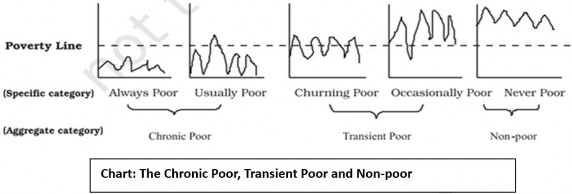Other Ways of Categorizing the Poor-
Chronic Poor- People who are always poor and those who are usually poor but who may sometimes have a little more money (example: casual workers) are grouped together as the chronic poor.
Churning Poor- Another group are the churning poor who regularly move in and out of poverty (example: small farmers and seasonal workers).
Occasionally Poor- Those who are rich most of the time but may sometimes have a patch of bad luck. They are called the transient poor.

1.3. Measuring Poverty
For the purpose of defining poverty, we divide people into two categories; the poor and the non-poor and the poverty line separates the two. However, there are many kinds of poor; the absolutely poor, the very poor and the poor. Similarly, there are various kinds of non-poor; the middle class, the upper middle class, the rich, the very rich and the absolutely rich. Think of this as a line or continuum from the very poor to the absolutely rich with the poverty line dividing the poor from the non-poor.

The Poverty Line: Poverty Line is a monetary threshold under which an individual is considered to be living in poverty. National Sample Survey Organization is the institution which collects data regarding estimation of poverty in India. There are many ways of measuring poverty. One way is to determine it by the monetary value (per capita expenditure) of the minimum calorie intake that was estimated at 2,400 calories for a rural person and 2,100 calories for a person in the urban area. Based on this, in 2011-12, the poverty line was defined for rural areas as consumption worth Rs 816 per person a month and for urban areas it was Rs 1,000. Thus the government uses Monthly Per Capita Expenditure (MPCE) as proxy for income of households to identify the poor.
